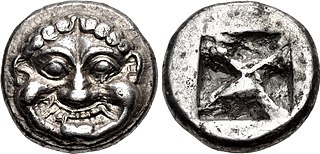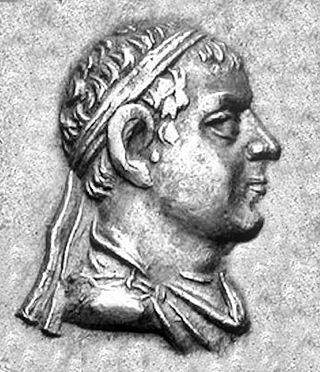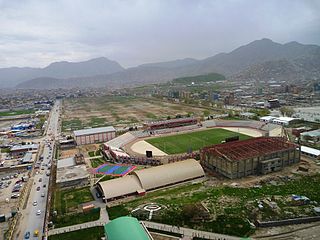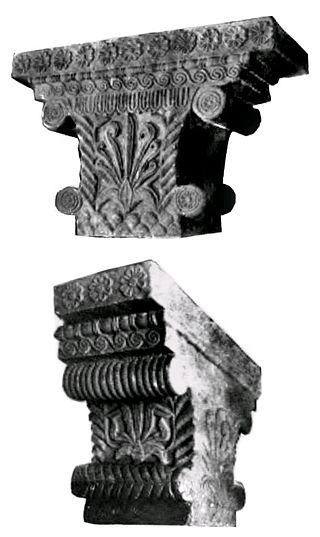
A coin is a small object, usually round and flat, used primarily as a medium of exchange or legal tender. They are standardized in weight, and produced in large quantities at a mint in order to facilitate trade. They are most often issued by a government. Coins often have images, numerals, or text on them. The faces of coins or medals are sometimes called the obverse and the reverse, referring to the front and back sides, respectively. The obverse of a coin is commonly called heads, because it often depicts the head of a prominent person, and the reverse is known as tails.

The history of ancient Greek coinage can be divided into four periods: the Archaic, the Classical, the Hellenistic and the Roman. The Archaic period extends from the introduction of coinage to the Greek world during the 7th century BC until the Persian Wars in about 480 BC. The Classical period then began, and lasted until the conquests of Alexander the Great in about 330 BC, which began the Hellenistic period, extending until the Roman absorption of the Greek world in the 1st century BC. The Greek cities continued to produce their own coins for several more centuries under Roman rule. The coins produced during this period are called Roman provincial coins or Greek Imperial Coins.

Philoxenus Anicetus was an Indo-Greek king who ruled in the region spanning the Paropamisade to Punjab. Philoxenus seems to have been quite an important king who might briefly have ruled most of the Indo-Greek territory. Bopearachchi dates Philoxenus to c. 100–95 BCE and R. C. Senior to c. 125–110 BCE.

Nicias was an Indo-Greek king who ruled in the Paropamisade. Most of his relatively few coins have been found in northern Pakistan, indicating that he ruled a smaller principate around the lower Kabul valley. He was possibly a relative of Menander I.

The Coinage of India began anywhere between early 1st millennium BCE to the 6th century BCE, and consisted mainly of copper and silver coins in its initial stage. The coins of this period were Karshapanas or Pana. A variety of earliest Indian coins, however, unlike those circulated in West Asia, were stamped bars of metal, suggesting that the innovation of stamped currency was added to a pre-existing form of token currency which had already been present in the Janapadas and Mahajanapada kingdoms of the Early historic India. The kingdoms that minted their own coins included Gandhara, Kuntala, Kuru, Magadha, Panchala, Shakya, Surasena, Surashtra and Vidarbha etc.

The Achaemenid Empire issued coins from 520 BC–450 BC to 330 BC. The Persian daric was the first gold coin which, along with a similar silver coin, the siglos represented the first bimetallic monetary standard. It seems that before the Persians issued their own coinage, a continuation of Lydian coinage under Persian rule is likely. Achaemenid coinage includes the official imperial issues, as well as coins issued by the Achaemenid provincial governors (satraps), such as those stationed in Asia Minor.

The tetradrachm was a large silver coin that originated in Ancient Greece. It was nominally equivalent to four drachmae. Over time the tetradrachm effectively became the standard coin of the Antiquity, spreading well beyond the borders of the Greek World. As a result, tetradrachms were minted in vast quantities by various polities in many weight and fineness standards, though the Athens-derived Attic standard of about 17.2 grams was the most common.

Chaman-i Hazouri or Hazoori Chaman is a park in downtown Kabul, Afghanistan. It is the site of the famous Chaman Hazouri hoard of ancient coins and jewellery dating back to the Achaemenid Empire, which is of key interest to the historians.

The Bhir Mound is an archaeological site in Taxila in the Punjab province of Pakistan. It contains some of the oldest ruins of Ancient Taxila, dated to sometime around the period 800–525 BC as its earliest layers bear "grooved" Red Burnished Ware, the Bhir Mound, along with several other nearby excavations, form part of the Ruins of Taxila – inscribed as a UNESCO World Heritage Site in 1980.

Punch-marked coins, also known as Aahat coins, are a type of early coinage of India, dating to between about the 6th and 2nd centuries BC. It was of irregular shape. These coins are found over most parts of subcontinent and remained in circulation till the early centuries CE.

Around 535 BCE, the Persian king Cyrus the Great initiated a protracted campaign to absorb parts of India into his nascent Achaemenid Empire. In this initial incursion, the Persian army annexed a large region to the west of the Indus River, consolidating the early eastern borders of their new realm. With a brief pause after Cyrus' death around 530 BCE, the campaign continued under Darius the Great, who began to re-conquer former provinces and further expand the Achaemenid Empire's political boundaries. Around 518 BCE, the Persian army pushed further into India to initiate a second period of conquest by annexing regions up to the Jhelum River in what is today known as Punjab. At peak, the Persians managed to take control of most of modern-day Pakistan and incorporate it into their territory.

Karshapana, according to the Ashtadhyayi of Panini, refers to ancient Indian coins current during the 6th century BCE onwards, which were unstamped and stamped (āhata) metallic pieces whose validity depended on the integrity of the person authenticating them. It is commonly supposed by scholars that they were first issued by merchants and bankers rather than the state. They contributed to the development of trade since they obviated the need for weighing of metal during exchange. Kārṣāpaṇas were basically silver pieces stamped with one to five or six rūpas ('symbols') originally only on the obverse side of the coins initially issued by the Janapadas and Mahajanapadas, and generally carried minute mark or marks to testify their legitimacy. Silver punch-marked coins ceased to be minted sometime in the second century BCE but exerted a wide influence for next five centuries.

Hellenistic influence on Indian art and architecture reflects the artistic and architectural influence of the Greeks on Indian art following the conquests of Alexander the Great, from the end of the 4th century BCE to the first centuries of the common era. The Greeks in effect maintained a political presence at the doorstep, and sometimes within India, down to the 1st century CE with the Greco-Bactrian Kingdom and the Indo-Greek Kingdoms, with many noticeable influences on the arts of the Maurya Empire especially. Hellenistic influence on Indian art was also felt for several more centuries during the period of Greco-Buddhist art.

Post-Mauryan coinage refers to the period of coinage production in India, following the breakup of the Maurya Empire.

Frataraka is an ancient Persian title, interpreted variously as “leader, governor, forerunner”. It is an epithet or title of a series of rulers in Persis from 3rd to mid 2nd century BC, or alternatively between 295 and 220 BC, at the time of the Seleucid Empire, prior to the Parthian conquest of West Asia and Iran. Studies of frataraka coins are important to historians of this period.
Mir Zakah is a village in the Mirzaka District of Paktia Province in eastern Afghanistan, and on the old caravan route from Ghazni to Gandhara.

The Shaikhan Dheri hoard is a small coin hoard that was discovered in 2007 at the site of ancient Pushkalavati in Ancient India, modern-day Pakistan. The hoard weighed 14 kilograms, contained "bent bars" as well as round coins "of a new type" as those discovered in the Kabul hoard. The hoard contained a tetradrachm minted in Athens circa 500/490–485/0 BCE, or possibly as early as 520 BCE, together with a number of local types as well as silver cast ingots. The Athens coin is the earliest known example of its type to be found so far to the east. This hoard exists in the context of the Achaemenid conquest of the Indus Valley. It can also be related to another famous hoard in the region, the Kabul hoard.
The Ghazzat hoard or Gaza hoard is a hoard of about 30 Archaic and early Classical Greek and Lycian silver coins discovered underwater near the shore of Gaza, Palestine.

The Croeseid, anciently Kroiseioi stateres, was a type of coin, either in gold or silver, which was minted in Sardis by the king of Lydia Croesus from around 550 BC. Croesus is credited with issuing the first true gold coins with a standardised purity for general circulation, and the world's first bimetallic monetary system.

The Apadana hoard is a hoard of coins that were discovered under the stone boxes containing the foundation tablets of the Apadana Palace in Persepolis. The coins were discovered in excavations in 1933 by Erich Schmidt, in two deposits, each deposit under the two deposition boxes that were found. The deposition of this hoard, which was visibly part of the foundation ritual of the Apadana, is dated to circa 515 BCE.












































